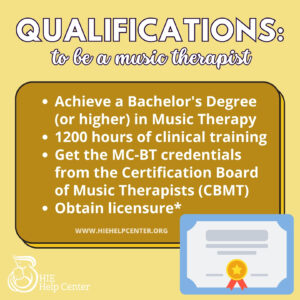History of Music Therapy
The idea that music can influence health and behavior is not exactly a new one; in fact, it can be traced back to the writings of Aristotle and Plato. A more organized use of music for therapeutic purposes emerged in the 20th century, when community musicians began visiting hospitals to play for veterans suffering from both physical and emotional trauma. These programs had such an impressive influence on the patients’ physical and mental states that hospitals began hiring musicians. However, it quickly became apparent that the health benefits of music could be strengthened if its uses in treatment were more formalized. The world’s first music therapy program, at Michigan State University, was founded in 1994. Other institutions also started to introduce programs around that time, including the University of Kansas, Chicago Musical College, College of the Pacific, and Alverno College.
Definition of Music Therapy
 The American Music Therapy Association (AMTA) defines music therapy as “the clinical and evidence-based use of music interventions to accomplish individualized goals within a therapeutic relationship by a credentialed professional who has completed an approved music therapy program.”
The American Music Therapy Association (AMTA) defines music therapy as “the clinical and evidence-based use of music interventions to accomplish individualized goals within a therapeutic relationship by a credentialed professional who has completed an approved music therapy program.”
How can music therapy help kids with HIE?
Music therapy can be used to address physical, emotional, cognitive, and social needs. Treatments depend on an individual’s symptoms, but may include creating or producing music, listening to music, and/or moving to the rhythm of music. While in most cases it should be used as a complementary treatment rather than a replacement for more ‘traditional’ options, research shows that it can aid in rehabilitative processes. When combined with movement, it can improve motor function. It can also increase a client’s motivation to participate in treatments such as physical therapy, serve as an outlet of expression for people who struggle to speak, provide emotional support, and much more.
Qualifications to Become a Music Therapist
 AMTA sets educational and clinical standards for music therapists. In order to become an accredited music therapist, one must possess a relevant bachelor’s degree, have 1,200 hours of clinical training, have the MT-BC credential (which is issued through the Certification Board for Music Therapists), and in some states, obtain licensure. Qualified and competent music therapists have in-depth knowledge of music as well as psychology and medicine.
AMTA sets educational and clinical standards for music therapists. In order to become an accredited music therapist, one must possess a relevant bachelor’s degree, have 1,200 hours of clinical training, have the MT-BC credential (which is issued through the Certification Board for Music Therapists), and in some states, obtain licensure. Qualified and competent music therapists have in-depth knowledge of music as well as psychology and medicine.
Music Therapy vs. Just Listening to Music
Although simply listening to music may also have health benefits, music therapy is distinct in that it involves a qualified therapist working with a client to achieve specific health goals. For example, if a musician with no therapeutic training performs for nursing home residents, it may make them feel better, but does not qualify as music therapy. The following are just a few examples of what music therapy can accomplish:
- Improve communication in children on the autism spectrum
- Help people regain speech after brain trauma (congresswoman Gabby Giffords relearned how to speak after surviving a bullet wound to her face, in part thanks to music therapy. Click here to learn more about her story)
- Decrease pain in hospitalized patients
- Increase motor function/movement
People Who May Benefit from Music Therapy
Music therapy can benefit people with a wide range of conditions. These include:
- Intellectual/developmental disabilities
- Learning disabilities
- Behavioral and emotional disorders
- Speech delays and language disorders
- Physical disabilities such as Parkinson’s and cerebral palsy (CP)
- Alzheimer’s disease
- Substance abuse issues
- Brain damage
- Pain (this includes chronic pain, as well as more acute forms such as labor)
Does Insurance Cover Music Therapy?
 True music therapy with a clear treatment plan (as opposed to more recreational or informal musical pursuits) is sometimes covered by insurance. Medicare may provide reimbursement for music therapy if it is prescribed by a doctor, deemed reasonable/necessary, and involves specific goals related to functional improvement. In some states, music therapy may also be available with Medicaid Home and Community Based Care waivers. Some private insurance plans also cover it. According to AMTA, about 20% of music therapists now receive third party reimbursements for their services.
True music therapy with a clear treatment plan (as opposed to more recreational or informal musical pursuits) is sometimes covered by insurance. Medicare may provide reimbursement for music therapy if it is prescribed by a doctor, deemed reasonable/necessary, and involves specific goals related to functional improvement. In some states, music therapy may also be available with Medicaid Home and Community Based Care waivers. Some private insurance plans also cover it. According to AMTA, about 20% of music therapists now receive third party reimbursements for their services.
Research on Music Therapy
Evidence supporting the effectiveness of music therapy is growing. AMTA produces two journals on this topic: the Journal of Music Therapy and Music Therapy Perspectives. The Journal of Music Therapy seeks to promote scholarship and critical inquiry focused on music therapy. They publish both quantitative and qualitative research, as well as pieces focused on the historical, philosophical, and theoretical aspects of music therapy.
 Music Therapy Perspectives is geared toward a more general audience, including readers who do not work in music therapy. It focuses on the clinical benefits of this type of treatment. To learn more about research projects on music therapy, click here.
Music Therapy Perspectives is geared toward a more general audience, including readers who do not work in music therapy. It focuses on the clinical benefits of this type of treatment. To learn more about research projects on music therapy, click here.
For more extensive information on music therapy, please visit AMTA’s website: https://www.musictherapy.org/

